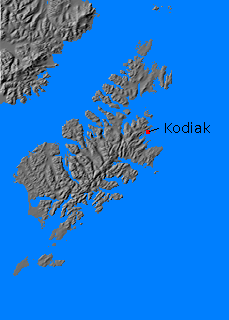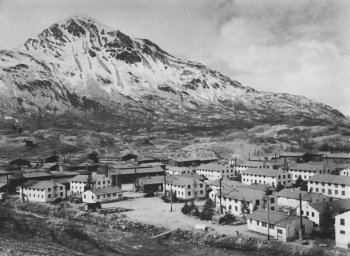![]() The Pacific War Online Encyclopedia
The Pacific War Online Encyclopedia
|
| Previous: Kobe | Table of Contents | Next: Kofu |
 |  U.S. Navy. Via ibiblio.org |
Kodiak Island (152.474W
57.757N) was discovered by Russian
explorer Stepan
Glotov in 1764. It is a large, mountainous island, with an area of 3588 square miles (9293 km2) and a heavily indented coastline. The climate is relatively mild due to the influence of the Kuroshio Current. In
1941, much of the terrain was blanketed with up to 8' (3m) of ash from
the eruption of Mount Katmai on the Alaskan Peninsula in 1912. This
hindered construction.
The port of Kodiak
was founded in 1792 and is
the oldest
permanent Western settlement in Alaska.
A
United States
naval station was established
here in 1939, and the U.S. Army activated Fort Greely on 3 April 1941. Fort Greely based 215 Coastal Artillery Regiment
(Antiaircraft), 37 Regiment, 201 Regiment, and 151 Engineer
Battalion when war broke out in the Pacific. By the end of the war, the naval base had three concrete
runways 5000', 5400' and 6000' feet long and 150' wide (1520m,
1650m, and 1830m long and 46m wide). There were also three seaplane
ramps and an 800' (244m) cargo pier and 450' (137m) tender pier. There was underground storage for 118,800 barrels of fuel oil, 27,000 barrels of diesel oil, 1,600,000 gallons of aviation gasoline,
and 567,000 gallons of motor gasoline. This was supplemented by above
ground storage for 55,000 barrels of fuel oil, 635 barrels of diesel
oil, 40,200 gallons of aviation gasoline, and 420,000 gallons of motor
gasoline, all in splinter-resistant steel tanks. There were also 39 magazines for ordnance and facilities for submarines..
The base could house 8,160 officers and men. However, construction was
slow, and only 72% of the facilities were completed by April 1943.
References
"Building the Navy's Bases in World War II" (1947; accessed 2012-3-20)
Stevens (2012; accessed 2014-6-6)
The Pacific War Online Encyclopedia © 2007-2008, 2012, 2014 by Kent G. Budge. Index